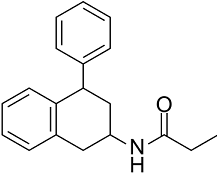
4-P-PDOT is a MT2-receptor-specific antagonist, it is >300-fold more selective for MT2 than MT1. 4-P-PDOT significantly counteracts Melatonin-mediated antioxidant effects (GSH/GSSG ratio, phospho-ERK, Nrf2 nuclear translocation, Nrf2 DNA-binding activity). In CHO-MT2 cells, 4-P-PDOT is an agonist, producing a concentration-dependent inhibition of forskolin stimulated cyclic AMP, with a pEC50 value of 8.72 and intrinsic activity of 0.86. In vivo, 4-P-PDOT (0.5-1.0 mg/kg; intravenous injection) treatment on klotho mutant mice significantly reverses antioxidant effects mediated by Melatonin.
| Molecular Weight | 279.38 |
| Formula | C19H21NO |
| CAS Number | 134865-74-0 |
| Form | Solid |
| Solubility (25°C) | DMSO ≥ 30 mg/mL |
| Storage |
Powder -20°C 3 years ; 4°C 2 years In solvent -80°C 6 months ; -20°C 1 month |
| Species | Mouse | Rat | Rabbit | Guinea pig | Hamster | Dog |
| Weight (kg) | 0.02 | 0.15 | 1.8 | 0.4 | 0.08 | 10 |
| Body Surface Area (m2) | 0.007 | 0.025 | 0.15 | 0.05 | 0.02 | 0.5 |
| Km factor | 3 | 6 | 12 | 8 | 5 | 20 |
| Animal A (mg/kg) = Animal B (mg/kg) multiplied by | Animal B Km |
| Animal A Km |
For example, to modify the dose of Compound A used for a mouse (20 mg/kg) to a dose based on the BSA for a rat, multiply 20 mg/kg by the Km factor for a mouse and then divide by the Km factor for a rat. This calculation results in a rat equivalent dose for Compound A of 10 mg/kg.
| Related Melatonin Receptor Products |
|---|
| Piromelatine
Piromelatine (Neu-P11) is a melatonin MT1/MT2 receptor agonist, serotonin 5-HT1A/5-HT1D agonist, and serotonin 5-HT2B antagonist. Piromelatine (Neu-P11) possesses sleep promoting, analgesic, anti-neurodegenerative, anxiolytic and antidepressant potentials. Piromelatine (Neu-P11) also possesses pain-related P2X3, TRPV1, and Nav1.7 channel-inhibition capacities. |
| ACH-000143
ACH-000143 is a potent and orally active melatonin receptor agonist, with EC50 values of 0.06 nM and 0.32 nM for MT1 and MT2, respectively. |
| S26131
S26131 (compound 5) is a potent and selective MT1 melatoninergic ligand, and the Ki values are 0.5 and 112 nM for MT1 and MT2, respectively. S26131 behaves as an MT1 and MT2 antagonist. |
| Agomelatine (L(+)-Tartaric acid)
Agomelatine L(+)-Tartaric acid (S-20098 L(+)-Tartaric acid) is a specific agonist of MT1 and MT2 receptors with Kis of 0.1, 0.06, 0.12, and 0.27 nM for CHO-hMT1, HEK-hMT1, CHO-hMT2, and HEK-hMT2, respectively. |
| Tasimelteon
Tasimelteon (BMS-214778) is a Dual Melatonin Receptor Agonist (DMRA) recently approved (Hetlioz) for the treatment of Non-24-hour sleep–wake disorder, a disorder primarily found in the totally blind, where a lack of normal synchronization between the 24-hour light–dark cycle and the endogenous circadian rhythm causes it to drift out of alignment with conventional sleep–wake schedules. |


Products are for research use only. Not for human use. We do not sell to patients.
© Copyright 2010-2023 AbMole BioScience. All Rights Reserved.
